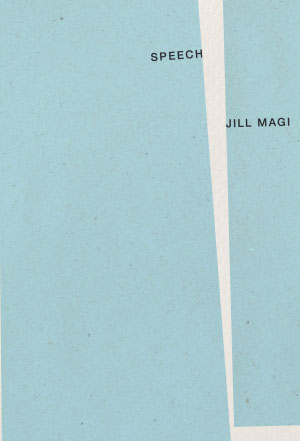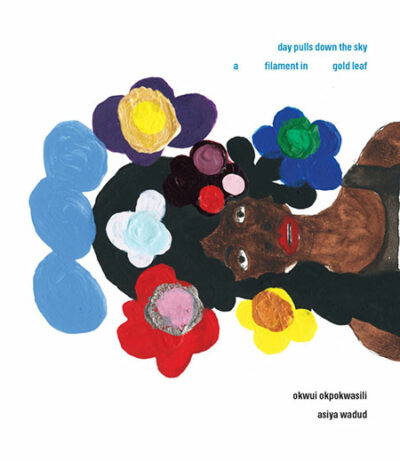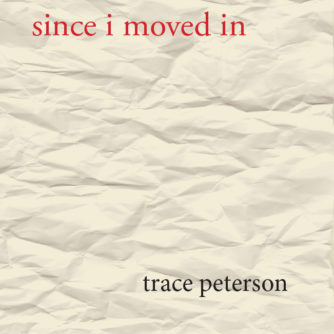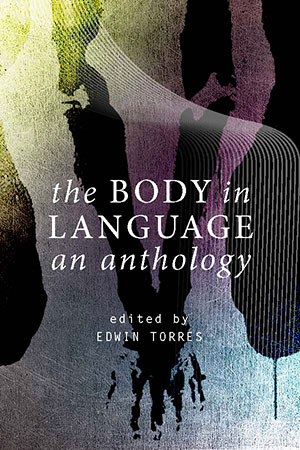Speech by Jill Magi
(Nightboat Books, forthcoming 2019)
One of my favorite things to do during the hot, humid summer months of NYC is to read poetry book after poetry book. There’s something about the air that makes the summer mind, disjointed and meandering from the past academic year, crave this kind of sinking into poetry.
I’ve been following Jill Magi’s work for over a decade and, with each new book or visual art piece, Magi builds a more layered thinking, stretching, imagining, where questions enlarge rather than diminish. Magi’s new book-length poem, SPEECH, is no exception. The dreamy light-blue cover of SPEECH is specked with bits of grayish black, conjuring Easter egg, ocean and graveled street. A fan of light or passageway shoots up the right side of the cover dividing the title, “SPEECH” on one side of it and “Jill Magi” on the other. The way this ray or band or passage divides these words already sets the book in a kind of wondering, or thinking space about our relation between words. Even the word “speech” itself brings me to reflect upon what it is, what it stands for. “Speech,” as in the mechanics of speaking, can mean the somewhat automatic action of how we communicate with words, or the more formal construction, the noun, “speech,” can refer to rhetoric that is carefully formed for effect and persuasion. In SPEECH, both kinds are deconstructed, speeches throughout history are woven in and reflected upon, speech as a given, as a “right,” is pushed against as an assumption, speech of the powerful versus those marked invisible, speech of different kinds: written, verbal, animal and sonic gestures are all carefully considered in this wide torrent of investigatory lyric.
The book begins with the line, “To misplace / my notebook / I welcome,” establishing the tone for what is to follow. A voice that is willing to challenge and broaden one’s own thoughts, comforts and rituals. There is a clarity in this stance, a willingness to think baldly about speech practices, and to lean into other experiences, to take risks. This also begins a walk, a walk through many geographies, classes, races, genders and cultures, which propels the questions and pushes against our constructs of what speech is or could be, how it is actualized, when it illumines brightly, and when it is snuffed, diminished. The writing is cutting and tender, and the mission large, “count borders / to cross out.” It’s a book that pushes against ideas of insularity, that mercilessly questions the writer’s own thinking: “Do I think about sovereignty as I walk / as I write?”
At a time when civil rights are increasingly precarious, and when hateful words and the acts that follow are trending, where economic power and greed canonize the like-minded and erase and/or kill those who are not, SPEECH is a radical, loving space to enter. When Magi writes, “Go tiny spider! / take your leap! / as I tangle in the web / of your temperature fluxing / it becomes me becomes / our indeterminacy. . .,” it is here that my heart swells, the invitation to compassion, to be active, to resist and to hold each other up.
day pulls down the sky / a filament in gold leaf by Okwui Okpokwasili and Asiya Wadud
(Belladonna*, 2019)
I’m interested in collaborative work where disparate pieces and disciplines can imprint the page, corresponding in a way that is more about community and dialogue than a tidy coherence. Such a collaboration exists in a beautiful book published by Belladonna* Collaborative and Danspace, day pulls down the sky / a filament in gold leaf. In day pulls down the sky, poet Asiya Wadud writes through the song lyrics of multidisciplinary artist, Okwui Okpokwasili. We are told in an introductory note that the musical sign for coda is scattered throughout the book, “in order to express the connection between Okpokwasili’s lyrics and Wadud’s poems.” The result is an energy filled with motion – and emotion. It’s difficult to not be roused by the charged quality of this project.
In the beginning Wadud writes, “a fibonacci builds in a chorus, as filament — all the congregants fervent in the / thickets — all the congregants fervent; we see them.” In this line, we are given a taste of the accretion that “builds” like a gigantic wave. There are the ongoing allusions to the structure of a fibonacci, which in its structure relies on cooperation, of looking behind in order to move ahead. This is a nod to the collaboration itself, the way a word like “filament” makes me not only think about tiny bits, but the idea of threading, which again brings me back to collaboration. But of course, both this line and this book are also about music, poetry, the ecstatic, “fervent” quality that can occur within it. “All the congregants,” are the readers/writers involved.
We dart down this same page to Okpokwasili’s lyrics “it is not that I have no past / Rather it continually fragments on the / Terrible and vivid ephemera of now /. . . .” Here not only do the themes of “fragments” and “filaments” resurface, but the oath is to be present, to be alive, and to pay attention. There’s also a lovely call and response that occurs between both their writing as Wadud above asks, “what brews inside the structure?” and Okpokwasili’s lyrics below Wadud’s query state, “I am / I am the face beneath the sand /. . .” When Wadud writes later, “we converged ; & saved space for filament,” I think, yes, that’s exactly what has happened here.
Time by Etel Adnan, translated by Sarah Riggs
(Nightboat Books, 2019)
Poet and translator Sarah Riggs writes in her recent translation of Etel Adnan’s Time, “The postcard is a medium Etel Adnan loves… As I myself currently sit at a table strewn with postcards to be written to my children at camp, I grapple with the space within a postcard. What can I say that won’t sound recycled, trite? Yet the “postcard-poems” of Time are anything but. To the eyes, they have air around them, neat and floating, while the words clamp with heft and assertion, “I say that I’m not afraid / of dying because I haven’t / yet had the experience / of death.” The assertion of course is questioning the assertion that is being made, so as the line tacks itself down it also unravels. This is like much of Adnan’s work, restless, thinking, and unwilling to quickly resolve. A work of place and placelessness, time and timelessness:
“I will travel, / motionless.” The work’s stability is in its instability and yet something strong and hopeful arises, “the invisible has no owner.”
Riggs’ wonderful translator’s note in the book explains that, as a result of her translation process, “I found the work seeping into my own as influence.” Translation, and poems built on correspondence, create particular kinds of spaces. With poems based on correspondence, it’s the lean toward relationality, the breath that must be left so to allow for another to sit and respond. Riggs herself has worked from a poetics of correspondence with books such as 28 Telegrams (dedicated to Etel Adnan) and 60 Textos (to Omar Berrada). Like Adnan’s work, you can feel the sear of the writing, impressed toward a specific other (in Adnan’s case we are told by Riggs that in 2003 Adnan “received a postcard at her home in Paris from her friend, Khaled Najar, the Tunisian poet and publisher of Tawbad Editions”, which prompted Time’s first sequence of poems), but the work is capacious and tender to allow all. In fact, while writing this piece I remember Sarah once sent me an email, inside of which was nested a poem from another series of correspondence that she was writing.
March 11, 2018
Dear Jennifer (Firestone),
The obliterated fields: more than time for the museums to give back
More than time for objects to go back
Time for mountains to be renamed their indigenous names
Time for crimes to be recognized
Time for reparations to be made for slavery
Time for the power of African communities to renew
Adnan’s Time is a book that crosses continents, encounters wars and heartbreaks, and looks brazenly at one’s own mortality. And these poems do exactly what Adnan states, “I would like to reflect like a / buoy, thrown out from the depths / to the luminous mortal surface / of the sea.”
Since I Moved In by Trace Peterson
(CHAX, 2019)
I’ve been reading Trace Peterson’s new and revised Since I moved In, and marveling at the unflinching honesty, not to mention the sharp, dexterous writing, that deeply tracks a transgender experience along with ideas about history, historizing, the woes of capital and its destructive path, and the investigation of home, location and geography. I’m moved by Since I Moved in— and the book moves also, kinetically, through a life that is variegated and lively, or as Peterson writes in “Bricky,” “Like a limpet held to a rock, I stay / to what moves me. . .” This determination, protest and declaration permeates this book, marked by the very language with which it grapples. This book is a lived experience, the real dangers, suffering and suffocation of a world of binaries: “There’s a lot to worry about / no clothing free of identity, no identity free of clothing.” It’s also a book that will open your heart with desire, curiosity and reach. Just listen to this opening stanza in the series, “Spontaneous Generation,” “It starts with a flow, under which wild plants grow, in the current, the opposite / of death. Become hands, reaching upward, out into forearms. Tangible aesthetic / summer, underground torso coming out of it.”
The Body in Language, edited by Edwin Torres
(Counterpath Press, 2019)
I’m a big fan of CA Conrad’s (Soma)tic writings and so the title of Edwin Torres’ new anthology, The Body in Language, caught my eye. Flipping through the diversity of voices and genres in The Body in Language, the project feels palpable, exciting, currently happening, not like the dustiness of some anthologies that try to keep hammering the same nails. I take Torres’ words to be true when he states, “The intent is not to categorize or restrict, but to explore, to reshuffle on each re-reading.” This book is corralled by Torres’ vision; I’ve always found Torres’ writing and performances enervating. Torres’ writes, “For the purpose of this anthology, each contributor’s work has been aligned with one of the four elements, each chapter representing one whole body composed of four elements.” This is an interesting. way to highlight connections between the body and language and also between the various writers in each section—there is a built-in connectivity/collaboration throughout.
The first page I landed on was Will Alexander’s “Out of the Ethers” (categorized under “Earth/Emotion). Alexander’s writing always blows my mind. Much like his tendril-like drawings that accompany the pages, Alexander’s work resist idea of fixation and stasis, “Therefore I can never be an enclosed example, a heretic roaming between fixation and fixation, a corpse, disclaiming my dense electrical animation.” Yes! This is a call for the potentiality of potentiality, and a rewiring and rethinking of origins and selves, where one is “enriched by circular ampersands.”
I then turned to CA Conrad’s selection (under Water/Thinking), where his “Introduction to (Soma)tic Poetry” explains the impetus and vision for such poetics. CA Conrad’s immense empathy and resilience is felt in the way he describes the deathly factory life under which his family had labored and, which he realized (in 2005) was diminishing his relationship to his own poetry. He writes, “(Soma) tics, ritualized structures where being anything but present was next to impossible.” In the poem, “Camisado” Conrad explains, “poetry is the opposite of escape / but makes this world endurable.” Hallelujah. “your hand around my shoulder / poet astronaut you know I love you.” Thankfully, a poet like CA Conrad exists and proliferates such warm magic.
There are a ton of interesting visual images in this book, Nancy Cohen’s “A Hanging Balance,” for one.
Tracie Morris’ “In Limbo” (under Air/Foundation) is an eloquent discussion of her body in relation to performance. There are so many amazing passages such as “In this particular body, the canal of air exits my gums, my teeth, rattle soft bones of my tender head. It’s a north wind from somewhere, a hot eastern current. This is the feeling that merges with the energy of the audience—what they’re saying without speaking-saying, how they feel, are feeling, out toward the stage.”




